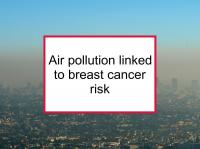Breast cancer rates tend to rise as countries become more urbanized. Much of this increase has been attributed to changes in diet and lower levels of physical activity. However, exposure to various forms of environmental exposures, including air pollution, also appears to play a part.
The incidence of breast cancer is reported to be higher in areas with greater levels of air pollution. Both the long-term time trend and geographic pattern of motor vehicle emissions have been positively associated with breast cancer rates. High levels of airborne particulates have also been found to be associated with reduced breast cancer survival.
Polycyclic aromatic hydrocarbons (PAHs) are chemicals formed during the incomplete burning of coal, oil and gas, garbage, food and other organic substances. PAHs are components of both vehicle exhaust and industrial air pollution. PAHs are also found in well-done or fried meat and fish. Women with high levels of PAH exposure, whether from diet or as a result of environmental factors, have been found to have higher risk of breast cancer than those with low exposure. Now a new study has reported that exposure to high levels of PAHs in ambient air increases breast cancer risk.
Air pollution and breast cancer
PAHs are the components of car exhaust that have been most consistently linked to risk of breast cancer. PAHs are stored in and accumulate in body fat, potentially resulting continual low-grade exposure to these carcinogens in nearby tissues. In fact, overweight and obese women are more susceptible to the breast cancer-promoting effects of PAHs than normal weight and underweight women. However, since motor vehicles are the primary source of nitrogen dioxide (NO2) emissions, NO2 is often used as a marker for motor vehicle-derived air pollution.
Other components of air pollution also appear to contribute to increased breast cancer risk. Higher ambient levels of acrylamide, benzidine, carbon tetrachloride, ethylidene dichloride, and vinyl chloride were found to be associated with increased risk of hormone receptor positive (ER+/PR+) breast cancer in one study, whereas higher ambient levels of benzene were associated with ER-/PR- disease.
Another study reported that reported that high levels of airborne particulates were associated with reduced survival among breast cancer patients in California. Ambient particulate matter consists of all the solid and liquid particles suspended in air at a given location. It includes soot, smoke, and other components of factory and automobile exhaust, as well as dust, pollen, and liquid droplets. Women with breast cancer living in areas with higher levels of ambient particulates were found to have shorter survival than those living in areas with lower exposures in this study. The greater the exposure, the higher the risk of early death.
Latest research links airborne PAHs from multiple sources to risk
The study referenced above was designed to investigate the association between PAHs in ambient air and breast cancer risk. The authors theorized that PAHs could be a factor in the geographic variation of breast cancer risk in the U.S. To examine this question, the researchers conducted an ecological study encompassing counties throughout the U.S. during the period 1973 to 2013. Data concerning age-adjusted rates of female breast cancer was collected from the surveillance, epidemiology, and end results (SEER) program of the National Cancer Institute. PAH emission levels were obtained from the Environmental Protection Agency (EPA). The analysis was adjusted for race, education, socioeconomic status, obesity, and smoking.
Age-adjusted rates of breast cancer were found to be significantly higher in more industrialized metropolitan SEER regions than in less industrialized regions. PAH emission density (both from all sources and from vehicular traffic alone) was also found to be significantly associated with breast cancer risk. The authors conclude that PAH exposure from ambient air contribute to the increased breast cancer risk found among women living in urban areas of the U.S.
